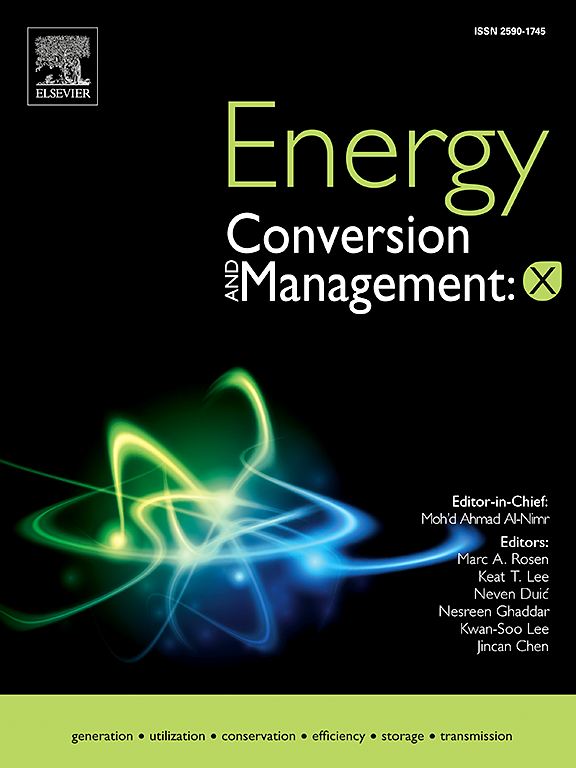CFD modelling of vertical-axis wind turbines using transient dynamic mesh towards lateral vortices capturing and Strouhal number
IF 7.1
Q1 ENERGY & FUELS
引用次数: 0
Abstract
This study investigated the aerodynamic performance of vertical-axis wind turbines (VAWTs) with a focus on optimising their design to enhance energy capture through lateral vortex dynamics, an aspect crucial for improving efficiency but often overlooked. Advanced Computational Fluid Dynamics (CFD) simulations were performed using a transient dynamic mesh approach to analyse the aerodynamic behaviour of three distinct VAWT prototypes under varying wind conditions. The results demonstrated that kinetic energy and torque were significantly enhanced with increasing inlet velocity. A maximum torque of 5.5 Nm was achieved by the two-blade Savonius turbine across wind speeds from 5 to 14 m/s, outperforming the helical Savonius turbine, which reached a peak torque of 2.5 Nm at 14 m/s. The two-blade turbine also attained a peak velocity of 19.1 m/s at 11 m/s, exceeding the helical turbine’s 13.3 m/s. This performance comparison clearly highlights the potential of the two-blade Savonius turbine in enhancing wind energy efficiency. Additionally, the incorporation of end plates in the helical turbine resulted in a 24.1% increase in maximum torque, demonstrating improved airflow regulation and turbine efficiency. Vortex shedding analysis revealed that Strouhal numbers () ranged from 0.05 to 0.130 for the two-blade turbine and from 0.040 to 0.070 for the helical turbine, with further reductions to 0.028 to 0.052 when end plates were added. These findings highlighted the critical role of lateral vortices in optimising turbine performance and demonstrated the potential of this approach for validating large-scale wind cluster simulations. Ultimately, new insights into VAWT aerodynamics were provided, paving the way for improved turbine design and enhanced wind farm efficiency.

基于瞬态动态网格的垂直轴风力机侧向涡捕获和Strouhal数CFD建模
本研究调查了垂直轴风力涡轮机(VAWTs)的空气动力学性能,重点是优化其设计,通过横向涡动力学来增强能量捕获,这是提高效率的一个重要方面,但往往被忽视。采用瞬态动态网格方法进行了高级计算流体动力学(CFD)模拟,分析了三种不同的VAWT原型在不同风况下的空气动力学行为。结果表明,随着入口速度的增加,动能和转矩显著增强。双叶片Savonius涡轮在风速5 ~ 14m /s范围内的最大扭矩为5.5 Nm,优于螺旋式Savonius涡轮,后者在风速为14m /s时的最大扭矩为2.5 Nm。双叶片涡轮在11米/秒时也达到了19.1米/秒的峰值速度,超过了螺旋涡轮的13.3米/秒。这种性能比较清楚地突出了双叶片Savonius涡轮机在提高风能效率方面的潜力。此外,在螺旋涡轮中加入端板导致最大扭矩增加24.1%,表明气流调节和涡轮效率得到改善。涡脱落分析表明,双叶片涡轮的斯特劳哈尔数(St)在0.05 ~ 0.130之间,螺旋涡轮在0.040 ~ 0.070之间,增加端板后,斯特劳哈尔数进一步降低到0.028 ~ 0.052之间。这些发现强调了横向涡在优化涡轮机性能方面的关键作用,并证明了这种方法在验证大规模风群模拟方面的潜力。最终,对VAWT空气动力学有了新的认识,为改进涡轮机设计和提高风电场效率铺平了道路。
本文章由计算机程序翻译,如有差异,请以英文原文为准。
求助全文
约1分钟内获得全文
求助全文
来源期刊

Energy Conversion and Management-X
Multiple-
CiteScore
8.80
自引率
3.20%
发文量
180
审稿时长
58 days
期刊介绍:
Energy Conversion and Management: X is the open access extension of the reputable journal Energy Conversion and Management, serving as a platform for interdisciplinary research on a wide array of critical energy subjects. The journal is dedicated to publishing original contributions and in-depth technical review articles that present groundbreaking research on topics spanning energy generation, utilization, conversion, storage, transmission, conservation, management, and sustainability.
The scope of Energy Conversion and Management: X encompasses various forms of energy, including mechanical, thermal, nuclear, chemical, electromagnetic, magnetic, and electric energy. It addresses all known energy resources, highlighting both conventional sources like fossil fuels and nuclear power, as well as renewable resources such as solar, biomass, hydro, wind, geothermal, and ocean energy.
 求助内容:
求助内容: 应助结果提醒方式:
应助结果提醒方式:


